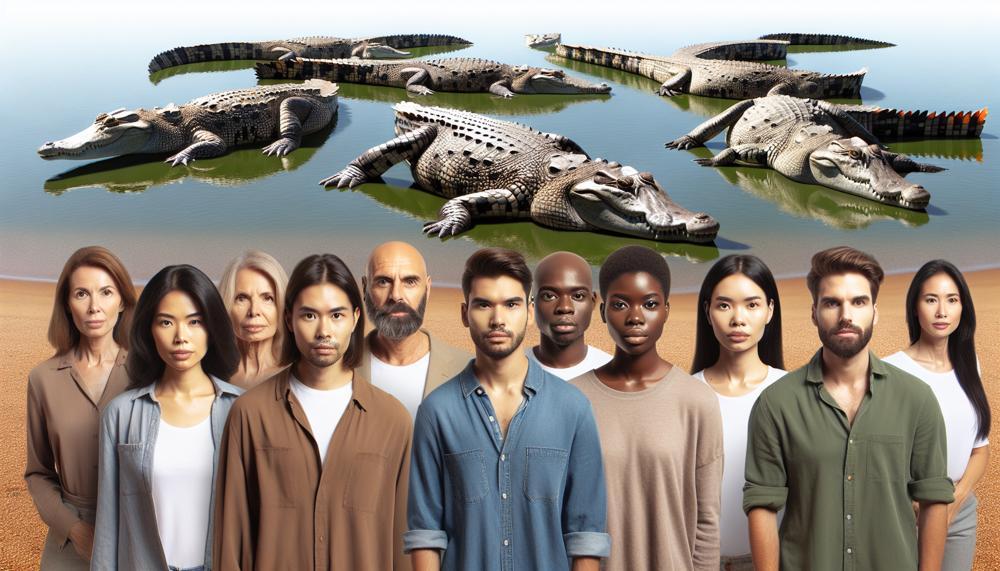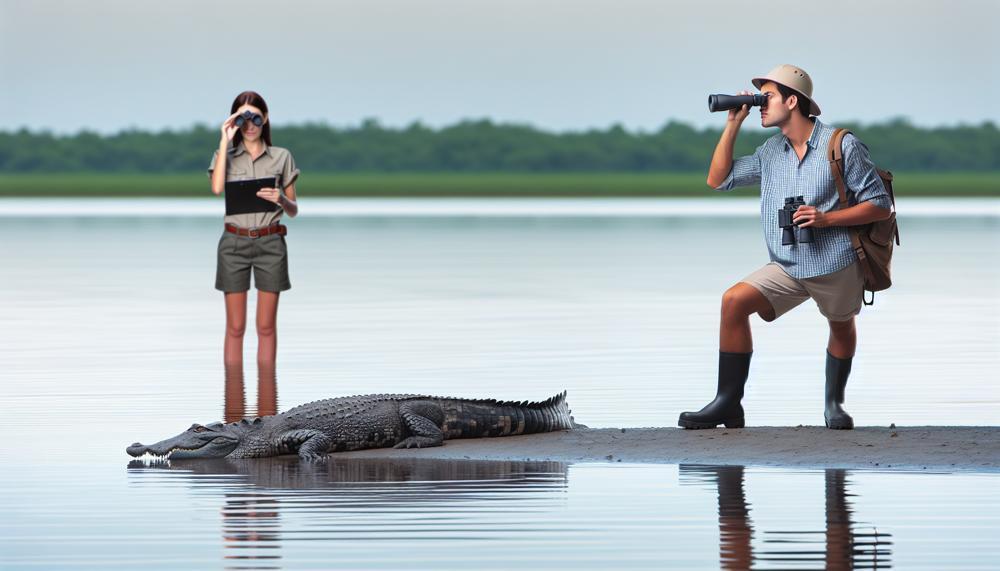Can Crocodiles Eat Humans? Exploring The Facts, Risks, And Myths
Crocodiles are among the most feared predators in the animal kingdom, and their reputation for attacking humans has been widely discussed. The question "can crocodiles eat humans?" has intrigued many people, but it's important to delve deeper into the truth behind this phenomenon. While the idea of a crocodile devouring a human may seem like something out of a horror movie, there are scientific and factual explanations that shed light on this topic.
Crocodiles are apex predators, equipped with powerful jaws and incredible strength, making them formidable hunters in their natural habitats. Despite their fearsome reputation, not all crocodile species pose a direct threat to humans. Understanding their behavior, diet, and interactions with humans can help us better assess the risks and learn how to coexist with these ancient creatures.
In this article, we will explore the reality of crocodile attacks on humans, the factors that contribute to such incidents, and the measures we can take to minimize risks. By the end, you'll have a clearer understanding of whether crocodiles can and do eat humans, as well as the broader implications of human-crocodile interactions.
Read also:Ainsley Earhardt Age Unveiling The Facts About The Renowned Fox News Host
Table of Contents
- Crocodile Biology and Behavior
- Crocodile Species and Their Diets
- Can Crocodiles Attack Humans?
- Statistics on Crocodile Attacks
- Why Do Crocodiles Attack Humans?
- Preventing Crocodile Attacks
- Common Myths About Crocodiles
- Comparing Crocodile Attacks to Other Animals
- Impact of Human Activities on Crocodile Habitats
- Conclusion: Living Safely Near Crocodiles
Crocodile Biology and Behavior
Crocodiles are reptiles that belong to the Crocodylidae family, and they have existed for millions of years. Their robust biology and behavior make them highly efficient predators. Crocodiles are cold-blooded, meaning their body temperature depends on the environment. They rely on basking in the sun to regulate their internal temperature and conserve energy.
One of the most striking features of crocodiles is their powerful jaws, which can exert immense pressure when biting down. This strength allows them to crush bones and tear apart large prey. Despite their slow movement on land, crocodiles are incredibly agile and fast in water, where they spend most of their time.
Crocodile Sensory Abilities
- Excellent vision: Crocodiles have sharp eyesight, even in low-light conditions.
- Keen sense of smell: They can detect prey from great distances using their olfactory senses.
- Vibration detection: Crocodiles possess specialized sensory organs called integumentary sense organs (ISOs) that help them detect vibrations in the water.
Crocodile Species and Their Diets
There are 23 recognized species of crocodiles, alligators, caimans, and gharials, but only a few are known to pose a significant threat to humans. The Nile crocodile and the saltwater crocodile are the two species most commonly associated with human attacks.
Each species has its own dietary preferences, but generally, crocodiles are opportunistic predators. Their diet typically includes fish, birds, mammals, and other reptiles. Larger crocodiles can consume prey as big as buffalo, zebras, and even sharks.
Key Crocodile Species
- Nile Crocodile: Found in Africa, this species is responsible for the majority of recorded crocodile attacks on humans.
- Saltwater Crocodile: Known as the largest living reptile, this species inhabits Southeast Asia and parts of Australia.
- American Crocodile: Primarily found in the Americas, this species is less aggressive toward humans compared to its African counterparts.
Can Crocodiles Attack Humans?
Yes, crocodiles can and do attack humans, but such incidents are relatively rare compared to other animal-related fatalities. Most attacks occur in regions where humans frequently come into contact with crocodiles, such as Africa, Southeast Asia, and Australia.
When a crocodile attacks a human, it is usually due to territorial behavior, self-defense, or mistaking a person for prey. In some cases, crocodiles may attack out of curiosity or aggression, especially if they feel threatened or provoked.
Read also:Ratatouille Cast Characters An Indepth Look At The Voices Behind The Magic
Types of Crocodile Attacks
- Predatory attacks: The crocodile actively hunts and consumes the human.
- Defensive attacks: The crocodile reacts to perceived threats, often resulting in non-lethal injuries.
- Mistaken identity attacks: The crocodile mistakes a human for prey, such as a floating object or animal.
Statistics on Crocodile Attacks
According to the IUCN Crocodile Specialist Group, there are approximately 300 to 500 reported crocodile attacks worldwide each year. However, the actual number may be higher due to underreporting in remote areas. The fatality rate of these attacks varies depending on the species and location.
In Africa, Nile crocodiles are responsible for an estimated 300 human fatalities annually. In Australia, saltwater crocodile attacks result in about 1 to 2 deaths per year, although non-fatal attacks are more common.
Factors Influencing Attack Statistics
- Human population growth near crocodile habitats.
- Increased tourism and recreational activities in crocodile-prone areas.
- Environmental changes that bring humans and crocodiles closer together.
Why Do Crocodiles Attack Humans?
Crocodiles attack humans for a variety of reasons, including hunger, territoriality, and self-defense. Understanding these factors can help reduce the likelihood of attacks.
One of the primary reasons for crocodile attacks is the overlap between human and crocodile habitats. As human populations expand, more people are venturing into areas where crocodiles naturally reside. This increases the chances of encounters and potential conflicts.
Common Reasons for Attacks
- Hunger: Large crocodiles may view humans as potential prey, especially if food sources are scarce.
- Territoriality: Crocodiles are highly territorial and may attack if they feel their space is being invaded.
- Curiosity: Juvenile crocodiles, in particular, may investigate unfamiliar objects, including humans.
Preventing Crocodile Attacks
While crocodile attacks cannot be completely eliminated, there are measures individuals and communities can take to reduce the risks. Education and awareness play a crucial role in preventing unnecessary encounters with these predators.
Local governments and conservation organizations often implement programs to educate the public about crocodile safety. These initiatives include warning signs, restricted access to water bodies, and guidelines for safe behavior in crocodile-prone areas.
Safety Tips Near Crocodiles
- Avoid swimming or wading in waters known to harbor crocodiles.
- Stay away from the water's edge, especially at dawn and dusk when crocodiles are most active.
- Do not feed or approach crocodiles, as this can encourage aggressive behavior.
Common Myths About Crocodiles
There are numerous myths and misconceptions surrounding crocodiles, many of which contribute to their negative reputation. Dispelling these myths can help foster a better understanding of these fascinating creatures.
For example, some people believe that crocodiles always attack humans on sight, which is untrue. Crocodiles are generally cautious and prefer to avoid contact with humans unless provoked or threatened.
Debunking Crocodile Myths
- Crocodiles do not cry "crocodile tears" out of sadness; this behavior is a natural physiological process.
- Not all crocodile species are dangerous to humans; many are shy and avoid interaction.
- Crocodiles are not mindless killers; they exhibit complex behaviors and social structures.
Comparing Crocodile Attacks to Other Animals
While crocodile attacks are undoubtedly dangerous, they pale in comparison to fatalities caused by other animals. For example, mosquitoes are responsible for millions of deaths each year due to diseases like malaria and dengue fever. Similarly, snakes, dogs, and even hippos cause more human fatalities than crocodiles.
This comparison highlights the importance of perspective when assessing the risks posed by different animals. While crocodiles deserve respect and caution, they are not the deadliest animals humans encounter.
Impact of Human Activities on Crocodile Habitats
Human activities such as urbanization, agriculture, and climate change have significantly impacted crocodile habitats. Wetlands and rivers, which are essential for crocodiles, are being destroyed or altered, forcing these animals to adapt to new environments.
Conservation efforts are crucial to ensure the survival of crocodile populations and minimize human-crocodile conflicts. Protecting natural habitats, enforcing wildlife laws, and promoting coexistence are key strategies in achieving this balance.
Conclusion: Living Safely Near Crocodiles
In conclusion, the question "can crocodiles eat humans?" has a nuanced answer. While crocodiles are capable of attacking and consuming humans, such incidents are relatively rare and often preventable. By understanding crocodile behavior, respecting their habitats, and following safety guidelines, we can reduce the risks associated with human-crocodile interactions.
We encourage readers to share this article with others and engage in discussions about wildlife safety. Together, we can promote a harmonious relationship between humans and these ancient predators. If you have any questions or experiences to share, please leave a comment below. And don't forget to explore our other articles on wildlife and conservation!


